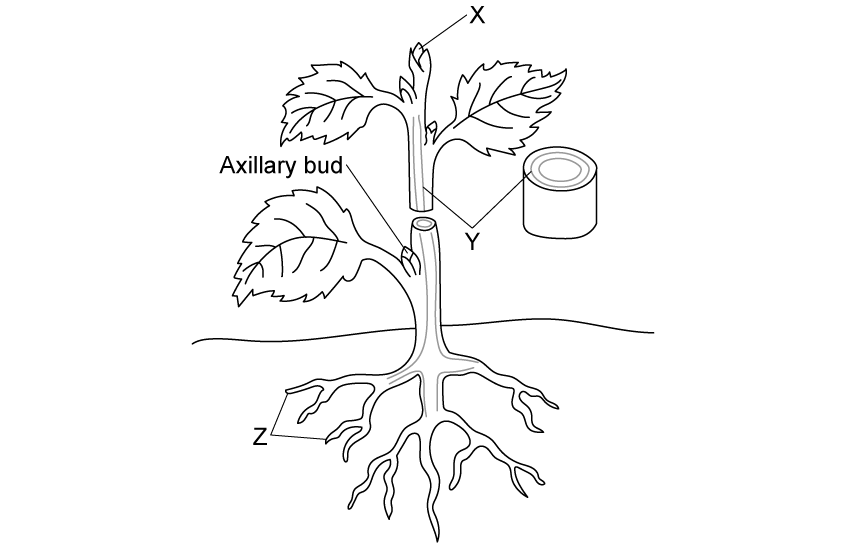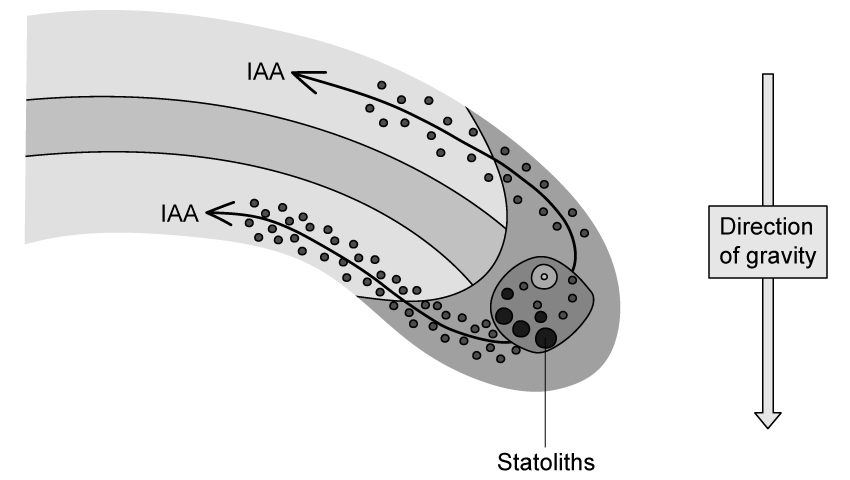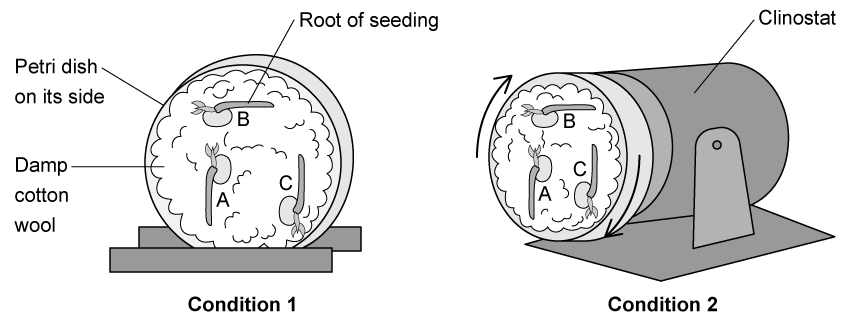a)
The image below shows a representation of a growing plant.
Identify structures X -Z in the image above.
[3 marks]
Assess your score
View Answer
b)
The cells in structures X -Z in part a) divide constantly.
i)
Identify the type of cell division taking place in structures X -Z .
[1 mark]
ii)
Describe what happens to the daughter cells produced by the process named in part i).
[2 marks]
Assess your score
View Answer
c)
State one feature of the cells found in structures X -Z in the image in part a) other than the feature described in part b).
[1 mark]
Assess your score
View Answer
d)
The image in part a) shows the location of regions known as axillary buds.
Describe the effect of the following plant hormones on axillary buds:
i)
Auxin
[1 mark]
ii)
Cytokinins
[1 mark]
Assess your score
View Answer
Next Question
a)
State the meaning of the term tropism .
[2 mark]
Assess your score
View Answer
b)
The diagram below shows the events taking place during a tropism in a plant root.
Explain the role of statoliths in this type of tropism.
[2 marks]
Assess your score
View Answer
c)
Other than the role of statoliths, outline the events that cause the tropism shown in part b).
[2 marks]
Assess your score
View Answer
d)
i)
Identify one example of a tropism other than the tropism shown in part b).
[1 mark]
ii)
Outline the benefit to the plant of the tropism identified in part i).
[2 marks]
Assess your score
View Answer
Previous Question Next Question
a)
An investigation was carried out into the effects of gravity on seedling root growth. The experiment was set up as shown in the diagram below.
Note that:
Both conditions 1 and 2 were set up in the dark.
A clinostat is a piece of equipment that rotates slowly over time.
Suggest the purpose of the following:
i)
Setting up the experiment in the dark.
[1 mark]
ii)
The damp cotton wool.
[1 mark]
iii)
The clinostat in condition 2.
[1 mark]
Assess your score
View Answer
b)
Identify a quantitative variable that the researcher could measure in the experiment shown in part a) to find out about the effect of gravity on the growth of seedling roots.
[1 mark]
Assess your score
View Answer
c)
Sketch the results that you would expect for seedling B in the experiment in part a) in:
i)
Condition 1
[1 mark]
ii)
Condition 2
[1 mark]
Assess your score
View Answer
d)
Experiments such as that shown in part a) can be used to find out about the large-scale effects of different stimuli on plant growth, but cannot tell researchers anything about the underlying processes inside plant cells.
Outline how modern scientists can find out about the processes occurring inside plant cells.
[2 marks]
Assess your score
View Answer
Previous Question Next Question
a)
Identify one feature of plant growth that makes plants suitable for micropropagation.
[1 mark]
Assess your score
View Answer
b)
State the reasons for each of the following stages of the micropropagation process:
i)
The explant is taken from meristematic tissue.
[1 mark]
ii)
The agar gel is sterilised.
[1 mark]
iii)
The agar gel contains 10 times more auxin than cytokinin.
[1 mark]
Assess your score
View Answer
c)
Identify three advantages of using micropropagation in plant production.
[3 marks]
Assess your score
View Answer
Previous Question Next Question
One mark is available for clarity of communication throughout this question.
a)
Outline the role of meristems in plant growth.
[6 marks]
Assess your score
View Answer
b)
Outline the role of auxin in the shoot response to light.
[3 marks]
Assess your score
View Answer
Previous Question


